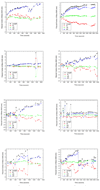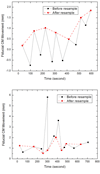Intrafractional motion of the prostate during hypofractionated radiotherapy
- PMID: 18722274
- PMCID: PMC2725181
- DOI: 10.1016/j.ijrobp.2008.04.051
Intrafractional motion of the prostate during hypofractionated radiotherapy
Abstract
Purpose: To report the characteristics of prostate motion as tracked by the stereoscopic X-ray images of the implanted fiducials during hypofractionated radiotherapy with CyberKnife.
Methods and materials: Twenty-one patients with prostate cancer who were treated with CyberKnife between January 2005 and September 2007 were selected for this retrospective study. The CyberKnife uses a stereoscopic X-ray system to obtain the position of the prostate target through the monitoring of implanted gold fiducial markers. If there is a significant deviation, the treatment is paused while the patient is repositioned by moving the couch. The deviations calculated from X-ray images acquired within the time interval between two consecutive couch motions constitute a data set.
Results: Included in the analysis were 427 data sets and 4,439 time stamps of X-ray images. The mean duration for each data set was 697 sec. At 30 sec, a motion >2 mm exists in about 5% of data sets. The percentage is increased to 8%, 11%, and 14% at 60 sec, 90 sec, and 120 sec, respectively. A similar trend exists for other values of prostate motion.
Conclusions: With proper monitoring and intervention during treatment, the prostate shifts observed among patients can be kept within the tracking range of the CyberKnife. On average, a sampling rate of approximately 40 sec between consecutive X-rays is acceptable to ensure submillimeter tracking. However, there is significant movement variation among patients, and a higher sampling rate may be necessary in some patients.
Conflict of interest statement
Figures











References
-
- Nichol AM, Brock KK, Lockwood GA, et al. A magnetic resonance imaging study of prostate deformation relative to implanted gold fiducial markers. Int J Radiat Oncol Biol Phys. 2007;67:48–56. - PubMed
-
- Zietman AL, DeSilvio ML, Slater JD, et al. Comparison of conventional-dose vs high-dose conformal radiation therapy in clinically localized adenocarcinoma of the prostate: a randomized controlled trial. Jama. 2005;294:1233–1239. - PubMed
-
- Pollack A, Zagars GK, Starkschall G, et al. Prostate cancer radiation dose response: results of the M. D. Anderson phase III randomized trial. Int J Radiat Oncol Biol Phys. 2002;53:1097–1105. - PubMed
-
- King CR, Lehmann J, Adler JR, et al. CyberKnife radiotherapy for localized prostate cancer: rationale and technical feasibility. Technol Cancer Res Treat. 2003;2:25–30. - PubMed
-
- Van den Heuvel F, Powell T, Seppi E, et al. Independent verification of ultrasound based image-guided radiation treatment, using electronic portal imaging and implanted gold markers. Med Phys. 2003;30:2878–2887. - PubMed
Publication types
MeSH terms
Grants and funding
LinkOut - more resources
Full Text Sources
Medical

